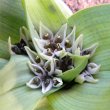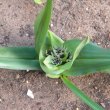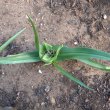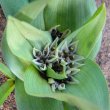| Botanical Name |
Androcymbium longipes - Colchicum longipes |
| Family |
Colchicaceae - The flame lily family. |
| Pronunciation |
an-dro-SIM-bee-um LON-juh-peez, KOHL-chik-um LON-juh-peez |
| Common Name(s) |
English: Men-in-a-boat; Cup-and-saucer
|
| Plant Group |
- Bulb / Corm / Rhizome / Tuber / Epigeal bulb Bulbs: are made up of fleshy scales as in an onion
Corm: a short, swollen, underground stem that is hard and not fleshy as in a gladiolus
Tuber: a solid, fleshy, underground, storage organ as in a potato
Rhizome: an underground, horizontal, swollen stem at the base of the plant as in an iris
Epigeal bulb: bulbs that rest above the ground with only the roots anchoring the plant to the earth as in albuca
- Veld Flower Small veld flowers of interest, rather than for their usefulness in the garden. Some of these plants have garden potential, particularly for less formal garden situations.
|
| Plant Size |
- Very Small
| Tree | 3m to 4m |
| Shrub | 25cm to 50cm |
| Perennial/ground cover | Up to 10cm |
| Bulb | 10cm to 20cm |
| Succulent | Up to 5cm |
|
| Position |
- Partial Shade The area is in shade for part of the day and in full sun for part of the day.
- Sun The area is in full sun for all or most of the day, all year round.
|
| General Information |
- Deciduous Plants which completely lose their foliage for part of the year.
- Drought Tolerance: Moderate The plant is moderately adapted to arid conditions and can survive short periods of drought and high temperatures without extra water.
- Frost: Tender A plant that will not survive any frost or low winter temperatures.
- Water Moderate These plants will need some extra watering compared to water-wise plants. Plant them together, in at least some shade and in a convenient proximity to the house so that grey water can be utilised during times of drought.
- Water Wise Plant species originating from low rainfall regions that require less water to survive and thrive than other plant species.
|
| Specific Information |
Androcymbium longipes arises from a slightly flattened tuber with a black fibrous covering. It usually has at least four leaves, the outer two straggling along the ground and the inner leaves standing erect. The plant is dormant in summer.
|
| Ad Break |
|
| Flowers |
| Description |
about six flowers with pointed, hooded petals and purplish styles, crowded at the base of the leaves
|
| Season |
- Winter Plants will seldom bloom for the entire season as given in the list, but should flower during a period within these parameters.
|
| Colour |
|
| Growth Rate |
- Moderate to Fast Specifying growth rate can be very misleading as there is considerable variation of growth rate depending on type and species of plant, available water, supplementary feeding, mulching and general care, as well as the plants suitability and adaptability to the garden environment.
|
| Plant Uses |
- Pot Plant A plant that needs a protected environment on a patio or indoors.
- Wild Garden An indigenous garden planted for the benefit of wildlife and birds. Provides food, water, a variety of mini-biomes and no poisonous chemicals are used.
|
| Distribution and Habitat |
in the Eastern Cape in the Karoo and from Grahamstown to East London on moist slopes, stony grasslands and coastal areas
|
| Planting Suggestions |
Androcymbium longipes requires well-drained soil but adapts to a wide variety of habitats, thriving even in the alkaline soil of my garden. Seeds germinate readily and flower in the second or third year. Keep drier during summer dormancy.
|
| Medicinal Uses |
The bulb is reportedly used for making an ointment for sore eyes.
|
| Ad Break |
|








Discuss this plant
Share knowledge, ask a question or give an experience.